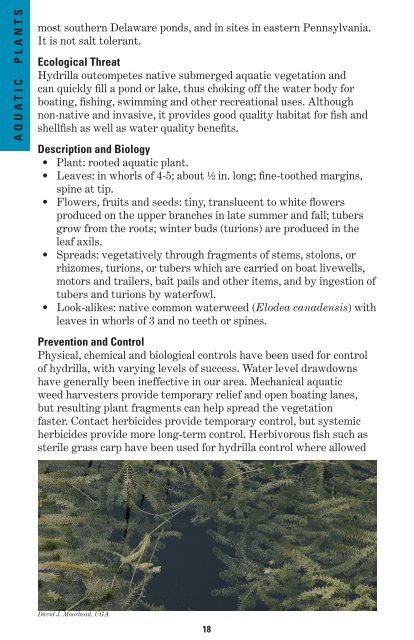Plant Invaders of Mid-Atlantic Natural Areas - National Park Service
Plant Invaders of Mid-Atlantic Natural Areas - National Park Service
Plant Invaders of Mid-Atlantic Natural Areas - National Park Service
You also want an ePaper? Increase the reach of your titles
YUMPU automatically turns print PDFs into web optimized ePapers that Google loves.
AQUATIC PLANTS<br />
most southern Delaware ponds, and in sites in eastern Pennsylvania.<br />
It is not salt tolerant.<br />
Ecological Threat<br />
Hydrilla outcompetes native submerged aquatic vegetation and<br />
can quickly fill a pond or lake, thus choking <strong>of</strong>f the water body for<br />
boating, fishing, swimming and other recreational uses. Although<br />
non-native and invasive, it provides good quality habitat for fish and<br />
shellfish as well as water quality benefits.<br />
Description and Biology<br />
• <strong>Plant</strong>: rooted aquatic plant.<br />
• Leaves: in whorls <strong>of</strong> 4-5; about ½ in. long; fine-toothed margins,<br />
spine at tip.<br />
• Flowers, fruits and seeds: tiny, translucent to white flowers<br />
produced on the upper branches in late summer and fall; tubers<br />
grow from the roots; winter buds (turions) are produced in the<br />
leaf axils.<br />
• Spreads: vegetatively through fragments <strong>of</strong> stems, stolons, or<br />
rhizomes, turions, or tubers which are carried on boat livewells,<br />
motors and trailers, bait pails and other items, and by ingestion <strong>of</strong><br />
tubers and turions by waterfowl.<br />
• Look-alikes: native common waterweed ( Elodea canadensis) with<br />
leaves in whorls <strong>of</strong> 3 and no teeth or spines.<br />
Prevention and Control<br />
Physical, chemical and biological controls have been used for control<br />
<strong>of</strong> hydrilla, with varying levels <strong>of</strong> success. Water level drawdowns<br />
have generally been ineffective in our area. Mechanical aquatic<br />
weed harvesters provide temporary relief and open boating lanes,<br />
but resulting plant fragments can help spread the vegetation<br />
faster. Contact herbicides provide temporary control, but systemic<br />
herbicides provide more long-term control. Herbivorous fish such as<br />
sterile grass carp have been used for hydrilla control where allowed<br />
David J. Moorhead, UGA<br />
18

















